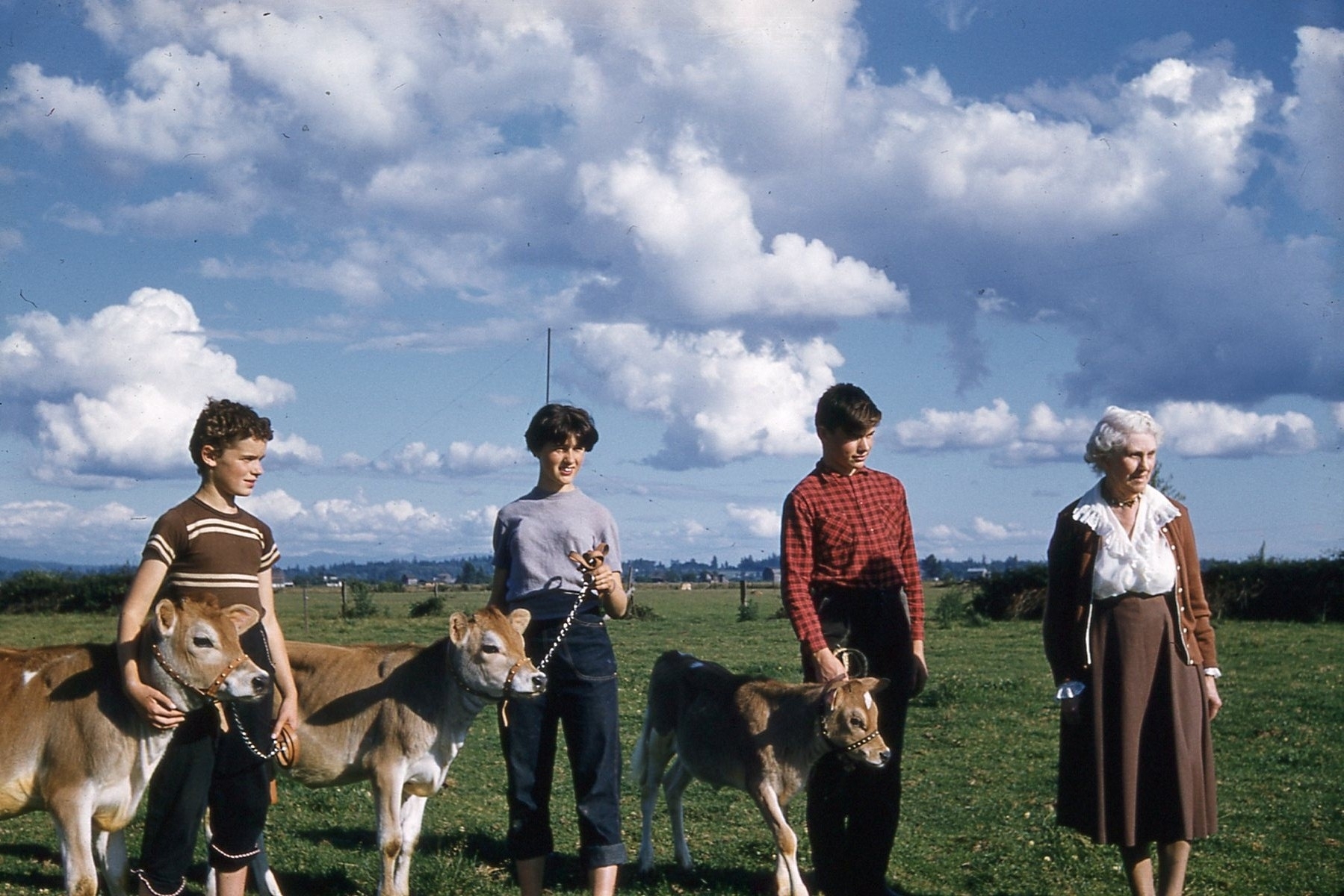The Farmers’ Institute organized a Calf Club 4-H work in the district for boys and girls ages 10 to 18 under the supervision of the Department of Agriculture in 1930. Each year achievement nights were held and prizes were given out. The Farmers’ Institute sponsored the 4-H clubs and supplied prize money. The Bank of Montreal donated the first cup. The Calf Club’s membership seemed to lapse in 1939 but was renewed again in 1953, under the direction of G. Williamson.<\/div>\r\n
<\/div>\r\n
The colour photograph is of the Brooke children and their paternal grandmother standing next to their calves. Their grandmother, Manie Brooke leads the line. Next to Manie is Arthur Brooke standing next to his calf. Following Arthur is his sister Daphne who is holding on to the reign of her calf. Finally, on the far left is Elizabeth Brooke (in grade 5) with her arm wrapped around the neck of Princess Fern (her calf). This photo is believed to be taken in May or June of 1957c. According to Elizabeth Brooke, on the day that this photo was taken her Grandmother came for a visit. She and her siblings took this opportunity to show off their 4-H calves to their grandmother. These 4-H calves were dairy calves trained on the halter, and trained to be showed off at the fair.<\/div>\r\n
<\/div>\r\n

The 4-H organization began in 1914 in British Columbia. The four H’s stand for head, heart, hands and health. The 4-H pledge is “I pledge my head to clearer thinking, my heart to greater loyalty, my hands to larger service, my health to better living for my club, my community and my country, and my world.” The objectives of 4-H clubs are knowledge, leadership, awareness of agriculture, preparation to become adult citizens and personal development in youth to become a positive impact in their communities. In the organization’s first year over 200 kids and teenagers between the ages of 10 and 18 became members of boys and girls clubs. Today, there are almost 3,000 young people between the ages of 6 and 21. The 4-H competitions were sponsored by the Department of Agriculture. The program focused on a variety of agricultural projects like potatoes, poultry, swine, dairy, sheep, corn etc. The Department of Agriculture provided training, instruction in judging and, support. In 1952 the boys and girls clubs were renamed to 4-H clubs. Later, youth with no farming background were allowed to participate by working on crafts, and learning about outdoor living and the environment.<\/div>","SEO_LINK":"calf-club-4h","VIDEO_LINK":"","SOUNDCLOUD_LINK":"","IMG1":"1697736739_main_1calf-club-4h.jpg","IMG2":"","IMG3":"","IMG4":"","IMG5":"","IMG6":"","IMG7":"","IMG1_THUMB":"","IMG2_THUMB":"","IMG3_THUMB":"","IMG4_THUMB":"","IMG5_THUMB":"","IMG6_THUMB":"","IMG7_THUMB":""}X
Calf Club 4H
The Farmers’ Institute organized a Calf Club 4-H work in the district for boys and girls ages 10 to 18 under the supervision of the Department of Agriculture in 1930. Each year achievement nights were held and prizes were given out. The Farmers’ Institute sponsored the 4-H clubs and supplied prize money. The Bank of Montreal donated the first cup. The Calf Club’s membership seemed to lapse in 1939 but was renewed again in 1953, under the direction of G. Williamson.
The colour photograph is of the Brooke children and their paternal grandmother standing next to their calves. Their grandmother, Manie Brooke leads the line. Next to Manie is Arthur Brooke standing next to his calf. Following Arthur is his sister Daphne who is holding on to the reign of her calf. Finally, on the far left is Elizabeth Brooke (in grade 5) with her arm wrapped around the neck of Princess Fern (her calf). This photo is believed to be taken in May or June of 1957c. According to Elizabeth Brooke, on the day that this photo was taken her Grandmother came for a visit. She and her siblings took this opportunity to show off their 4-H calves to their grandmother. These 4-H calves were dairy calves trained on the halter, and trained to be showed off at the fair.
The 4-H organization began in 1914 in British Columbia. The four H’s stand for head, heart, hands and health. The 4-H pledge is “I pledge my head to clearer thinking, my heart to greater loyalty, my hands to larger service, my health to better living for my club, my community and my country, and my world.” The objectives of 4-H clubs are knowledge, leadership, awareness of agriculture, preparation to become adult citizens and personal development in youth to become a positive impact in their communities. In the organization’s first year over 200 kids and teenagers between the ages of 10 and 18 became members of boys and girls clubs. Today, there are almost 3,000 young people between the ages of 6 and 21. The 4-H competitions were sponsored by the Department of Agriculture. The program focused on a variety of agricultural projects like potatoes, poultry, swine, dairy, sheep, corn etc. The Department of Agriculture provided training, instruction in judging and, support. In 1952 the boys and girls clubs were renamed to 4-H clubs. Later, youth with no farming background were allowed to participate by working on crafts, and learning about outdoor living and the environment.
Details:
Latitude: 49.2270602469183
Longitude: -122.68997457089
Direct Link: https://www.pittmeadowsmuseum.com/locations/calf-club-4h



Welcome to the Pitt Meadows Museum and Archive's Memories Mapping Project!
Click on the map to add your history or explore what others have left.
This project funded in part by:
Government of British Columbia
BC | Canada 150 Grants